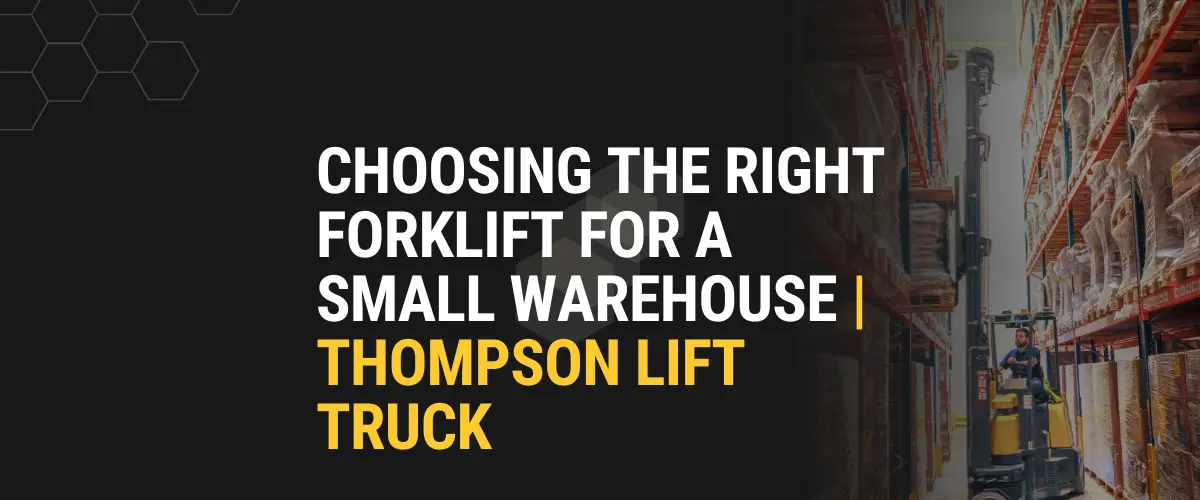
Choosing the Right Forklift for a Small Warehouse
Space is tight. Aisles are narrow. Turns are sharp. If you run a small warehouse, you already know: not every forklift is built for your environment.
The wrong machine can slow things down or even cause damage. But the right one? It helps you move more product with fewer headaches.
So, what should you look for when choosing a forklift for a small warehouse? Let’s walk through it. From maneuverability to power type to aisle width, here’s how to find a forklift that fits your operation.
Why Small Warehouses Need a Different Approach
Big distribution centers have room to spare. Most small warehouses don’t. You might be working with older building layouts, low ceilings, or tight racking that was never designed for standard-size equipment.
In this kind of setting, a forklift that’s just “pretty good” won’t cut it.
You need something that can:
- Turn in narrow aisles
- Operate safely in tight spots
- Be energy efficient
- Work quietly, if the environment requires it
- Handle smaller loads quickly and reliably
It’s not about size for the sake of size. It’s about finding something that’s built to handle your space and still get the job done.
Forklift Types That Work Well in Smaller Warehouses
There’s no one-size-fits-all. But here are some of the best forklift types we recommend for smaller facilities:
1. Electric Forklifts
Electric models are popular for a reason. They’re compact, quiet, and produce no exhaust fumes. That makes them ideal for indoor warehouses, especially those without great ventilation.
Electric forklifts also tend to have smaller turning circles and lower noise levels, which matters in tight, busy areas. They’re a good fit if your loads are under 10,000 lbs and you want to reduce maintenance.
2. Narrow Aisle Forklifts
As the name suggests, these are designed to work in tighter aisle widths, usually around 8 to 10 feet. That’s compared to standard forklifts, which need 12 feet or more to turn.
Narrow aisle forklifts help you use your space more efficiently. More racks. More product. Less wasted room.
3. Stand-Up Forklifts
If your operators need to hop on and off frequently, a stand-up forklift can speed up the workflow. They’re easier to maneuver in tight areas and usually have better visibility in cramped zones.
Stand-up models are often used in small warehouses with high throughput, like food service, retail fulfillment, or parts distribution.
4. Walkie Stackers and Pallet Jacks
For very tight spots or low-ceiling areas, a walk-behind option might be enough. These smaller units are great for short runs, small pallets, or areas where a full-size forklift would be overkill.
They’re also budget-friendly and easy to train new staff on.
Factors to Consider When Choosing a Forklift for a Small Warehouse
Let’s say you’re choosing between a few models. Here’s what to keep in mind:
Aisle Width
Measure your narrowest aisle, not just where you expect the forklift to go, but everywhere it might need to turn or back out of. Then check the right angle stacking aisle width on any forklift you’re considering. That’s the real number to compare.
Load Capacity
Don’t overbuy. You don’t need a forklift rated for 15,000 lbs if your average load is half that. Stick to the smallest capacity that meets your needs. That helps with maneuverability and cost.
Lift Height
Small warehouses don’t always have tall ceilings, but if you do, make sure the forklift can lift high enough, and that the mast can collapse low enough to get through your doorways when not in use.
Power Source
Electric forklifts are usually best for indoor settings, especially when ventilation is limited. They’re quieter, cleaner, and cost less to run over time. Just make sure you’re set up to handle charging stations.
Operator Visibility and Comfort
In tighter spaces, visibility is critical. Some models offer better sightlines or lower-profile designs. If your team is running the machine all day, look at comfort features too. That includes ergonomic controls, ease of entry, and adjustable seating or standing platforms.
Mistakes to Avoid
Here are a few common slip-ups we’ve seen:
- Choosing a model based only on price, not turning radius
- Forgetting to check the collapsed height for storage
- Ignoring the battery charging setup needed for electric models
- Picking a forklift that’s too heavy for your floor rating
- Not considering how often the forklift will run in reverse or in narrow alleys
This is where talking to a dealer helps. We’ve worked with warehouses of all shapes and sizes and can point out what might cause problems later.
Let’s Find the Right Fit
Whether you need one forklift or five, Thompson Lift Truck can help you find the right model for your warehouse.
We stock a wide range of compact, efficient forklifts from brands like Hyundai, Crown, and Combilift. And we don’t just sell them: we service them, too. That means we’re thinking beyond the sale to what’s going to work for your team six months, one year, and five years down the line.
FAQs: Forklifts for Small Warehouses
What is the best forklift for a small warehouse?
Electric and narrow aisle forklifts tend to work best. The right choice depends on your aisle width, load size, and how much space you have to maneuver.
How narrow can an aisle be for a forklift?
With narrow aisle forklifts, you can operate in aisles as narrow as 8 feet. Standard forklifts usually need 12 feet or more.
Are electric forklifts better for indoor use?
Yes. Electric models are quieter, cleaner, and don’t produce emissions, which makes them ideal for enclosed warehouse spaces.
What’s the smallest type of forklift?
Walkie stackers and electric pallet jacks are compact options for very tight spaces or light-duty lifting.
Can Thompson Lift Truck help me choose the right forklift for my building?
Yes. We’ll look at your space, layout, and budget to recommend the best models for your warehouse.

